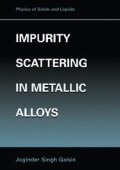Abstract
Metals were perhaps the first elements to have been utilized by humans. Metals were employed to make both ornaments and sharp weapons. Today the metallic materials (metals and their mixtures) play an indispensable role in engineering, technology, and industry. All tools and machines ranging from a sewing needle to automobiles and aircraft are made of various metallic materials. These materials thus constitute one of the most important classes of the engineering materials.
Access this chapter
Tax calculation will be finalised at checkout
Purchases are for personal use only
Preview
Unable to display preview. Download preview PDF.
Author information
Authors and Affiliations
Rights and permissions
Copyright information
© 2002 Springer Science+Business Media New York
About this chapter
Cite this chapter
Galsin, J.S. (2002). Introduction. In: Impurity Scattering in Metallic Alloys. Physics of Solids and Liquids. Springer, Boston, MA. https://doi.org/10.1007/978-1-4615-1241-7_1
Download citation
DOI: https://doi.org/10.1007/978-1-4615-1241-7_1
Publisher Name: Springer, Boston, MA
Print ISBN: 978-1-4613-5457-4
Online ISBN: 978-1-4615-1241-7
eBook Packages: Springer Book Archive

